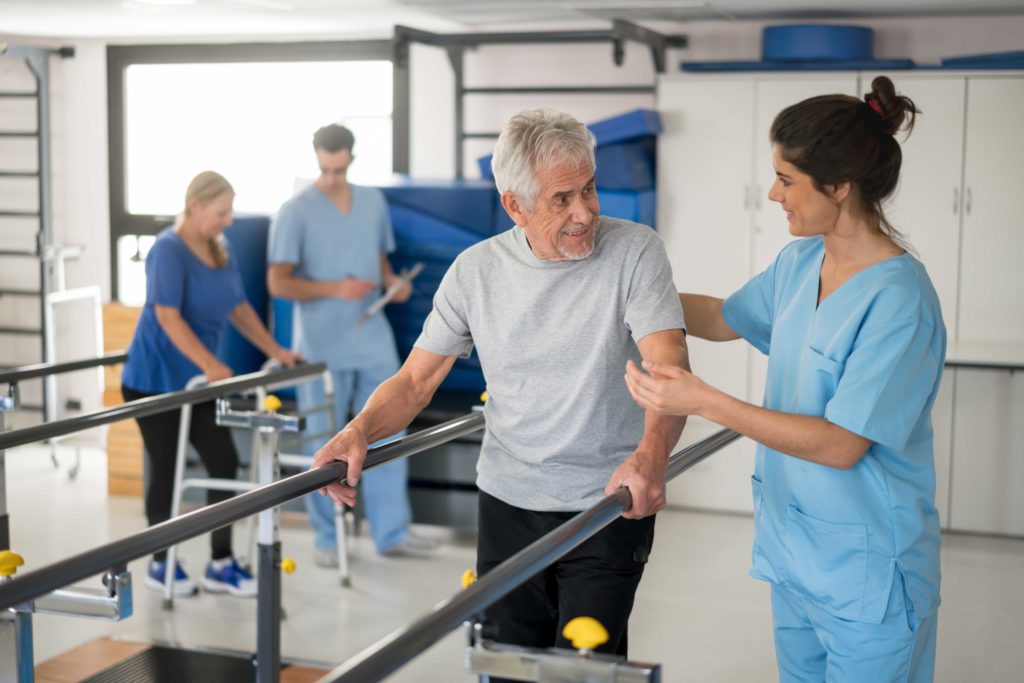We are dedicated to serving our patients in a way that sees them through illness or injury with a sense of hope. When surgery is part of a comprehensive treatment plan, we often also incorporate physical therapy as an aspect of rehabilitation.
Reasons for Physical Therapy After Surgery
There are several reasons why physical therapy is commonly prescribed for surgical patients.
- Physical therapy facilitates healing. Tissues regain strength and flexibility, range of motion and stability, through stretching and exercise. The precision movements performed in a physical therapy treatment program can help a patient regain the use of a limb or restore proper movement to a body part that has been injured.
- Balance and range of motion can improve with a course of physical therapy. It isn’t only necessary to restore proper movement in an area on which surgery has been performed. In the bigger picture, physical therapy can facilitate the implementation of compensatory movements during recovery or go so far as to help a patient learn to stand, walk, and move on a new joint.
- Prompt physical therapy exercise after surgery inhibits the buildup of scar tissue. Scar tissue is much less flexible than healthy tissue. Without adequate and targeted motion following surgery, the repaired area of the body may become extraordinarily stiff. To regain full use of the body part, it is necessary to break up scar tissue, which is generally an uncomfortable process. Physical therapy may prevent this occurrence.
- A vital part of recovery after surgery, physical therapy promotes faster healing and improved range of motion. As a result, patients can return to their active lifestyle and reduce their need for prescription pain medication more quickly.
Expectations During Physical Therapy
One of the primary goals of physical therapy is to help you regain your ability to perform normal daily activities. Achieving that goal takes time and, possibly, numerous strategies.
Initially, your physical therapist will conduct a comprehensive medical history. At Summit Healthcare Orthopedic Center we also use Physical Therapy Assistants (PTAs).

Every patient will be evaluated by a Physical Therapist, but PTA’s may perform subsequent treatments. They may perform several screenings to evaluate posture, strength, coordination, balance, and more. This initial stage of care may observe how you walk, how to lift and bend, and how you sit or stand. Furthermore, your therapist may ask for more information about your daily activities and home or work environment. The information gathered during your intake visit helps your therapist determine goals and develop a course of care.
During active physical therapy appointments, your therapist will likely demonstrate special exercises that you will do on your own at home. You may also be taught different ways to modify different activities so they are easier to perform and reduce strain on your body. As physical therapy progresses, the therapist continually monitors the progress of rehabilitation and corresponds with your primary healthcare team as needed or requested by you.
What is Physical Therapy?
Physical therapy is an area of healthcare in which the focus is on the evaluation and treatment of various physical limitations. Services provided by a licensed physical therapist revolve around improving functional mobility after an injury. This may be accomplished using specific rehabilitative exercise, manual therapy, and numerous different modalities. For example, in addition to facilitating and overseeing the performance of functional exercises to improve mobility, a physical therapist may also utilize heat, electrical stimulation, ultrasound, or other therapeutic methods to restore proper body mechanics.

What are the benefits of physical therapy?
Physical therapy can mean the difference between a future with chronic pain or reduced function due to an injury or a future with normal function and mobility and better quality of life. No matter your age, regaining the strength and range of motion that is achieved with physical therapy is a critical component of health care. Here are some benefits of physical therapy:
- Pain management with less need for medication
- Avoiding surgery
- Improved mobility and movement
- Full recovery from injury or trauma
- Return to function after stroke or paralysis
- Prevention of future falls
- Improved balance
- Management of age-related medical problems
What to wear during physical therapy
Physical therapy appointments typically involve stretching, moving, and exercising. Your physical therapist may ask you to wear shorts or loose-fitting clothing to your visits. This allows you to properly perform prescribed movements and also allows your therapist to observe how your muscles are moving and interacting. It is also necessary to wear comfortable exercise shoes to physical therapy; the kind you would wear to the gym or on a good power-walk.
When you come see our PT team at Summit Healthcare Orthopedic Center, our first session is an evaluation. It will take usually one and a half to two hours. Your regular sessions will take approximately one hour, depending on the complexity of your rehabilitation. Although individual situations are different, physical therapy usually involves between 12 and 24 sessions. These will run from one to two months.

Patients can expect to feel slightly sore or uncomfortable after physical therapy sessions. If you encounter discomfort that decreases your commitment to your therapy program, talk with your therapist. Strategies can be implemented to help you recover faster after each session. These include icing the area that is sore, drinking plenty of water to process the toxins released due to inflammation, and taking approved medication as directed.
Physical therapy has the goal of getting the patient’s complete body back from injury, surgery, or setback. Physical therapy takes the patient’s entire body into account, seeking to get the patient back walking, working on his or her balance, and increasing overall strength and core strength. Physical therapy works to regain range of motion and function.
Occupational therapy is task-oriented. It focuses more on the upper extremities, the arms and hands, as it has more narrow, defined goals. These are to improve the patient’s ability to perform the activities of daily living. OT targets fine motor skills, memory-type exercises, and cognitive strategies. OT is intended to get you back into your normal life.

In these instances, physical therapy encompasses a larger goal beyond simply returning function or strengthening an injured area. Physical therapy for older adults can have these benefits beyond typical PT for younger patients:
- Reducing the risk of a future fall — Falls are the leading cause of accidents among seniors, and PT will move beyond the recovery from a current fall to preventing another fall in the future.
- Lowering the risk of injury — PT for seniors may work to maintain stability to reduce the risks of injury or re-injury.
- Decreasing pain from chronic conditions — PT can help a patient deal with the pain and inconvenience of conditions such as arthritis, Parkinson’s disease, or osteoporosis.
- Lessening the need for prescription drugs — PT can reduce a senior patient’s need for various prescription medications.
- Maintaining independence — PT can allow older patients to maintain their independent lifestyle rather than having to change to a living situation with more involved care.
At Summit Healthcare Orthopedic Center our physical therapists and physical therapy assistants all have the training and experience to ensure there is a little risk during your physical therapy. We teach proper technique, and we provide the necessary supervision to keep you progressing, not regressing with an injury. We weigh every exercise or manipulation against the individual patient’s strength, balance, and overall condition before initiating anything.
The real risk of physical therapy is not doing it or not adequately following your home exercises. Without physical therapy patients often won’t recover fully, will suffer from more chronic pain, and have a lower quality of life moving forward.
